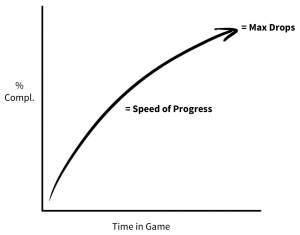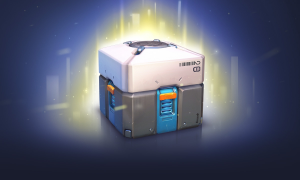Cómo diseñar un sistema Gacha
Recientemente visité Pocket Gamer Connects en Helsinki y presenté una charla sobre Gacha.
Aquí tenéis el vídeo de la presentación:
Aquí están mis diapositivas:
Pocket Gamer Helsinki 2017: Receta para un Gacha fuerte (PDF)
Pocket Gamer Connect Helsinki – Receta para Gacha fuerte de Adam Telfer
Resumiendo la Presentación, hay 3 aspectos claves que son claves para que un sistema Gacha funcione: profundidad , ancho y deseo .
#1 Profundidad
- La profundidad de Gacha se trata de garantizar que tu gacha dure el mayor tiempo posible.
- La gacha durará mucho tiempo hasta que los jugadores se queden sin contenido (o razones para abandonar la gacha)
- La gacha durará mucho tiempo hasta que sienta que un jugador no está logrando un progreso significativo con ella.
- La profundidad de Gacha es crítica cuanto más juegos dependen en gran medida de Gacha como su principal retención y monetización (por ejemplo, todos los juegos que copian los sistemas de progresión y Gacha de Clash Royale).
- Cuanto más profunda sea tu gacha, mayor será tu retención a largo plazo + gasto económico máximo, lo cual es fundamental para el éxito en F2P.
- Para saber cuál es la profundidad de tu modelo gacha, necesitas modelar tus caídas máximas . (lee aquí si no sabes qué significa gotas)
- Construya un modelo usando Excel, Google Spreadsheets o codifíquelo
- Este modelo debe tener en cuenta variables clave que afectan el ritmo y la profundidad de tu gacha:
- cuanto contenido tienes
- Para qué se utilizan tus duplicados
- Cantidad de rarezas y sus tasas de aparición
- Cambios en el grupo (como agregar y eliminar qué contenido se puede eliminar de Gacha)
Usando el modelo puedes calcular un gráfico que te muestre efectivamente cómo se sentirá tu gacha .

- Esto debería mostrarle una dinámica clara de cómo aumentar el número de caídas que su sistema puede manejar:
- Agregar contenido agrega profundidad , pero depende de cuál sea el tipo de rareza
- Las tasas de caída bajas para niveles superiores significan un progreso más plano y frustrante
- Abrir el grupo con el tiempo significa que los jugadores pueden sentir que el gacha está "renovado" y es interesante nuevamente.
- ex. Hearthstone lanza nuevos paquetes de contenido cada pocos meses y resulta gratificante abrirlos al instante.
- ex. Clash Royale abre el grupo de Gacha con el tiempo para brindar razones convincentes para gastar cada vez que subes de nivel de Arena.
- ex. Dragonvale abre nuevas posibilidades de Gacha Pool cada vez que desbloqueas un nuevo elemento en el juego.
- Darle significado a los duplicados de tu progreso (no solo convertirlos en polvo) agrega profundidad exponencial a tu sistema gacha .
- Dust les da a los jugadores una mejor base de progreso, a costa de la velocidad de progreso (reduciendo su profundidad)
- Duplicates that are required to progress (ex. Clash Royale’s duplicate system) mean that in order to upgrade cards you require sometimes hundreds of duplicates (depending on the rarity) adding significant depth AND making each drop feel rewarding
#2 Width
- Gacha width is about ensuring that your systems put pressure on having a wide collection of content as much as possible.
- Gacha width is about ensuring that players don’t feel terrible after bad drops.
- To do this, make all content as relevant and helpful as possible.
- 4 examplefeatures that drive width:
- Loadout Size
- Asking the player to bring in a variety of items into the core battle
- ex. in Call of Duty your Loadout includes a gun, pistol, weapon attachments, etc.
- ex. in Hearthstone you bring in 30 cards, Clash Royale you bring in 8
- ex. in Contest of Champions you bring 3 heroes to a campaign
- you want just enough that collecting matters, but not so many that players can create a perfect team
- Asking the player to bring in a variety of items into the core battle
- Explicit Strengths and Weaknesses
- Element systems are needed to ensure that there is no perfect team, and players need to constantly shift their team around to take advantage of the situation.
- ex. Contest of Champions has 6 elements in their game, plus synergy bonuses
- Element systems are needed to ensure that there is no perfect team, and players need to constantly shift their team around to take advantage of the situation.
- Implicit Counters
- Fostering debate amongst your audience about what the optimal setup for a meta is will drive strong collection.
- The more content the player has — the more they can experiment or be prepared for a shifting meta
- Game Modes
- Including game modes within your game which explicitly rewards players for having a large quantity of heroes.
- ex. Gauntlet mode in Heroes Charge or Galactic War in Galaxy of Heroes: the more heroes you have, the longer you’ll survive, the higher you are rewarded
- Including game modes within your game which explicitly rewards players for having a large quantity of heroes.
- Loadout Size
#3 Desire
- Gachadesire is about ensuring that your game’s progress is effectively paced by the gacha content. Players NEED the gacha in order to progress in the game.
- Look at your systems, how important is the content of the gacha to progress?
- How important is Skill? can a player with high skill breeze through your game? willa player with low skill feel like the gacha isn’t helpful?
- Are there mechanics within the game which water down the usefulness of the gacha?
- ex. progression systems on the side of the gacha system which are more important than the content of the gacha
- Look at your systems, how important is the content of the gacha to progress?
These 3 lenses can be used to look into your own Gacha to ensure it will be as powerful as you need it to be.
In the coming months, pocketgamer will post the video of the presentation. I’ll post it then.
 Related ReadBrawl Stars vs Clash Royale : Designing a Strong GachaIn Deconstructions, MonetizationAdam Telfer
Related ReadBrawl Stars vs Clash Royale : Designing a Strong GachaIn Deconstructions, MonetizationAdam Telfer Related ReadCreating a Strong Gacha: How the Pros Make Sure Duplicates Aren’t ‘Bad Drops’In Monetization, DeconstructionsAdam Telfer
Related ReadCreating a Strong Gacha: How the Pros Make Sure Duplicates Aren’t ‘Bad Drops’In Monetization, DeconstructionsAdam Telfer Related ReadGetting Back to the Roots of Gacha: 5 Things We Learned Developing Dragon’s WatchIn Deconstructions, DesignGuest Writer
Related ReadGetting Back to the Roots of Gacha: 5 Things We Learned Developing Dragon’s WatchIn Deconstructions, DesignGuest Writer Related ReadCómo diseñar cajas de botín y sistemas Gacha
Related ReadCómo diseñar cajas de botín y sistemas Gacha
Leave a Reply